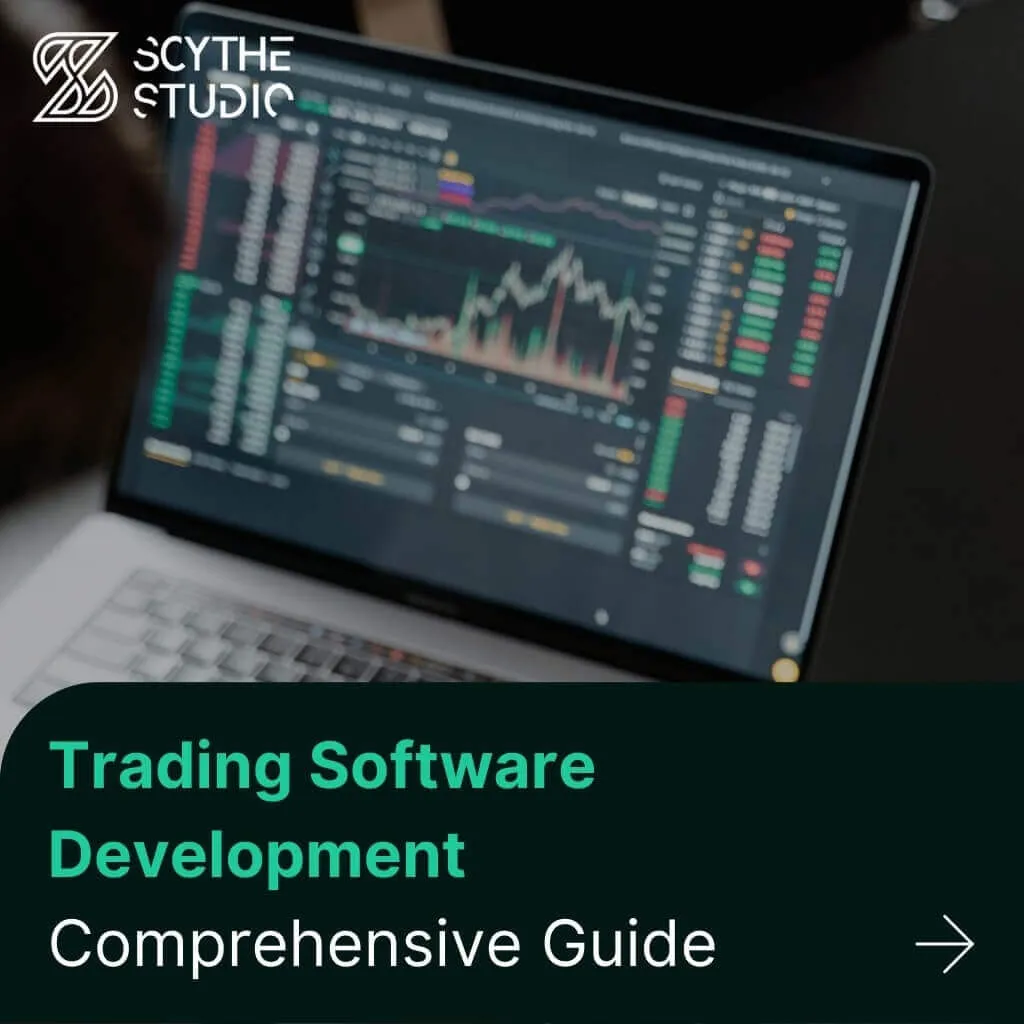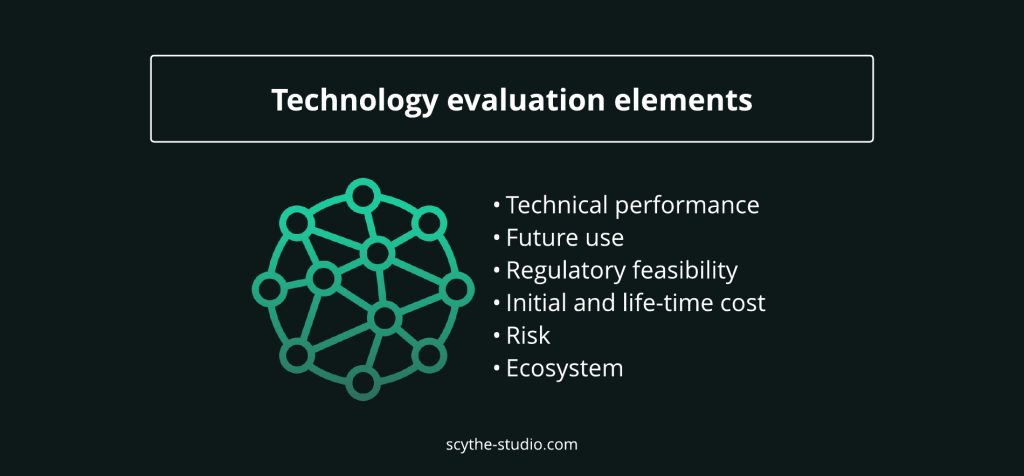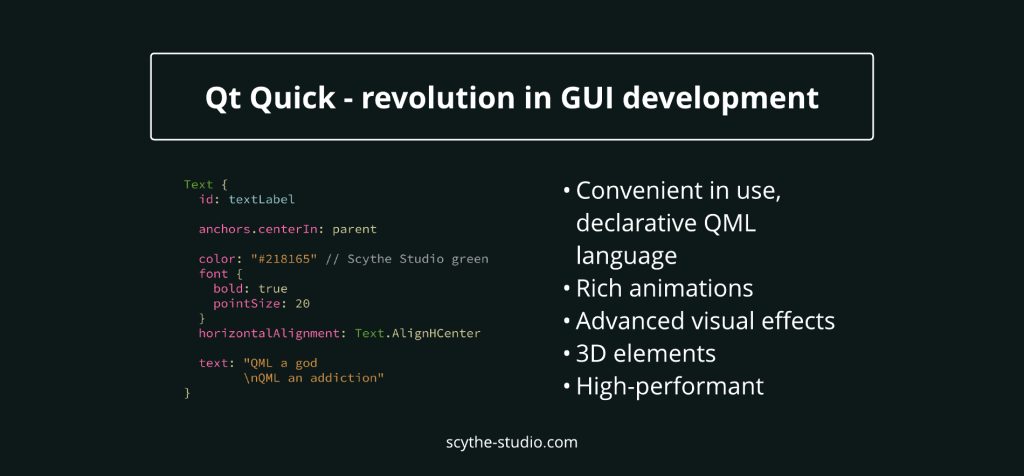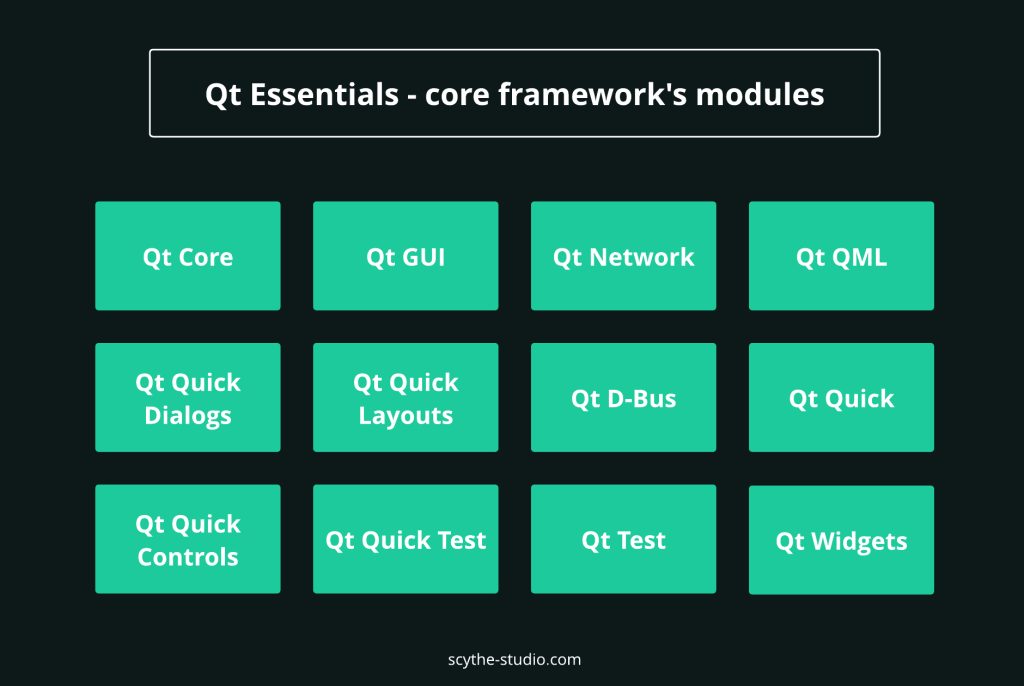
Trading Software Development: A Comprehensive Guide
Trading software refers to the digital platforms and systems that enable investors and financial institutions to buy, sell, and manage […]
Join us at Qt C++ Warsaw Meetup - 21.08.2025
Sign up for free!
Nowadays, software development is an integral part of the medical project creation. It is not a surprise as medical software solutions are among the most cutting-edge projects.
At Scythe Studio, we have been providing custom healthcare software development services for medical devices producer that was creating 3D printers using biological cells as the material. Not to mention projects of highly-precise surgical robots.
At this very moment, while I am writing this blog post, 80% of our projects at Scythe Studio are medical software development. Therefore, it is a good opportunity to communicate some of our thoughts on the technical side of programming for this industry.
If you are looking for help with your healthcare project then don’t hesitate to check out our medical device software development services page.
We will focus on custom healthcare software development projects such as medical devices and other more sophisticated cases. Not only this part of medical software will be covered. We will also include medical apps that are intended to be used on desktops or the app will closely communicate with a system of other devices – Internet of Medical Things (IoMT).
This blog post won’t touch the topic of healthcare software types such as telemedicine projects, electronic health records (EHR) systems, hospital management software, or web/mobile patient portals. The projects which focus on mobile and web platforms are simply more similar to typical software solutions. Of course, it doesn’t mean that there are any special factors to consider or dedicated tools to use.
I’m going to start this paragraph with a short personal story about my laser vision correction. It is going to give us some background and examples to help you understand the importance and benefits of software in the healthcare sector.
In the beginning, my eyes were examined by doctors using special medical devices. The results of the corneal topography, among others, were first checked with image processing programs that were highlighting the interesting parts for the doctor.
On the day of the procedure, I lay down on a bed with a special laser device next to me. The device politely asked the doctor to input some parameters and except for a small, yet crucial task the doctor had nothing to do. It took them 5 minutes and there were 5-6 other patients with me.
From that day I (and hopefully other patients too) have a perfect vision and nothing to complain about. I’ve never spent my money better.
Having this example in mind, let’s then summarize list the reasons to launch custom healthcare software development projects.

The laser was operated by healthcare software running on that medical device. It placed itself in a proper position, over my eye, and did its thing according to the parameters provided by the medical staff. The entire process was super delicate and precise, yet very safe. The same level of accuracy could not be provided by a human. A person would sooner or later make a mistake.
Each healthcare organization hires the best possible professionals. However, they are still humans. Well-trained, image-processing AI with a huge base of medical data to learn from would spot an issue during digital patient data analytics faster. Some changes can be barely spotted or simply not spotted by the human eye. Naturally, it has to be coded first with the assistance of healthcare specialists.
It is one of many examples of how software engineers can help medical professionals in their regular job. Properly programmed healthcare software can do more than humans in many aspects. It can be more precise and robust. The healthcare industry can only benefit from that.

Coming back to the story with my laser eye vision correction that was performed thanks to healthcare software used during several stages before and during the operation. The day I had the treatment there were three rounds of those healthcare procedures. In the morning, at noon, and in the late afternoon. More than ten people got a better vision that day.
How much time would it take to do all of the examinations without custom healthcare software? Well, it probably wouldn’t be possible, but even if so, then it would take a lot of time. Using software helps health organizations make savings in terms of time. I believe that I do not need to explain how money is saved then.
Innovators and people leading medical software development companies may wonder what technology would be the most suitable for custom healthcare software. As always, it strongly depends on both the functional and non-functional requirements of the system to create. There is no easy answer to this question. However, there are some facts about the realities of custom healthcare software development that may help you make the decision.

It may sound strange and naive, but before you start anything you should make sure that it is possible. In this aspect, custom healthcare software development does not differ much from regular software development. The difference is that medical software may have more sophisticated and unusual applications.
Before you start considering the right technology for healthcare software development, you need to sit down and prepare a requirements analysis. Both functional (exact features) and non-functional requirements (for example robustness and maintainability) matter in this case. Technology should not block you at any point and cause the project to be canceled or delayed.
Therefore, make an effort and ensure that a particular feature can be implemented using a given technology. The most unusual and demanding features should be your main focus. For example, let’s say that your healthcare software has to have a DICOM viewer on one of the screens. DICOM viewer makes it possible to view and analyze CT (Computed Tomography) and MRI (Magnetic Resonance Imaging). It is a popular requirement for many custom healthcare software development projects. Before you start the project you need to check if it is possible to do that using a particular technology.

Remember that you need to be careful when making decisions on the technology stack to go with. A possible solution is not always the optimal one. Flutter – a popular framework may do fine for UI implementation and it is possible to implement DICOM viewer using it, but there are not many existing examples of such healthcare software, so it would cost you a lot to develop such a thing from scratch.
You can check out our blog on developing DICOM medical imaging software.
Another factor is the technical requirements for the medical software that you want to create. Custom healthcare software development is often a single part of a bigger system. The system may consist of several components including specialized robots and embedded systems.
You need to make sure then, that technology that you choose can implement the communication within this system. Also, ensure that your custom medical software can be deployed on a particular platform.
At Scythe Studio, as a custom healthcare software development company, we make sure that technology will not block us at any point if we decide to migrate to different operating system or on another embedded hardware platform. You will learn more about our technology of choice later.
The healthcare industry is one of the most regulated sectors. It should not surprise us as the results of operations and medical data analytics performed by healthcare software have to be accurate. Medical devices should be under regulations as well. They can cause serious injury or even death, so that’s for good that regulatory services take care of this before a product is available on the market.
One of the most known standards is IEC 62304. It specifies the requirements and activities for medical device software development. It is demanding, but it tells you whether you go in the right direction while developing custom medical software for your device.
It could be the topic of another article, but let’s take a quick look at software safety classification. Software is classified by its safety based on the potential hazard of harm or injury to the user or patient. There are 3 classes – A, B, and C. Class C is for software that can lead to an unacceptable risk of serious injury or death. Below is a flow diagram that helps identify classes.

However, how do the certifications and standards influence the choice of technology? They do not. IEC 62304 standard regulates the process, not technology. Therefore, you should be able to use any technology as long as you can prove and provide the required documentation for every process (development planning, requirements analysis, architectural design, unit verification, etc) from the healthcare software development cycle.
There are no exact guidelines for documentation, but you should document how you deal with the risk. There are technologies out in the market, like Qt framework, that already have tools that are certified. It may be helpful if you develop custom medical software that needs them.
Custom healthcare software development solutions usually cost a lot of time and money. Therefore such solutions are in use for a long time. Healthcare organizations expect that money invested once in a particular medical device will pay off after some time. As the result, the once-purchased solution stays in use for a long time.

Choosing a technology that is young and not stable is unacceptable! There is a rule to choose boring technology always. Choose technology that is well-known in the industry, is mature, and yet constantly developed. Why is it so crucial? You need to make sure that the technology that you choose for your healthcare software, is mature and will provide a satisfying level of support for long-term versions.
Of course, after some time, it may turn out that the choice was a poor one. It happens. You need to do your best to make sure that the choice is right. Before you start the development planning for your software, make the research detailed enough to ensure that the technology will not be a bottleneck for your medical software.
You can either do it on your own or contact a healthcare software development company such as Scythe Studio. As mentioned earlier, the majority of our projects are about medical software development services. Mostly for medical devices software. We help healthcare organizations realize their ideas by providing them with skilled designers, managers, and engineers with a practical experience in software development for this industry.

Feel free to visit our medical software development services subpage to learn more about our services and offerings for the healthcare industry. Keep reading to discover the technology that Scythe Studio as the healthcare software development company, uses for all of our projects.
Let’s shortly introduce Qt – the framework that is our main area of expertise and that is widely recognized as a way to go for many healthcare software development companies. After the introduction, you will see examples of software created using this exact technology.

Qt is a C++ programming framework recognized mostly thanks to the unique approach to graphical user interface (GUI) programming. Of course, Qt is naturally connected to UI development, but in fact, it satisfies a lot of other needs while developing software. Implementing connectivity or unit tests are just examples. Qt is also available in Python programming language. Many scientific and statistics apps like patient data analytics software are coded using Qt and Python.
We are happy to be an official service partner of the Qt Group – a company backing up the Qt framework. It is a guarantee that we are a Qt consulting company that you can trust.
Qt framework is commonly used in multiple sectors such as healthcare, automotive or industrial automation. Using Qt you can develop software running on low-level hardware, HMI for the automotive cockpit, or regular mobile app. It’s a multi-purpose framework. Nevertheless, you care mostly about the usage of the Qt framework for the healthcare industry. Let’s then take a look at some examples of typical medical use cases.
If you are into healthcare software development, you probably heard the DICOM term several times. Anyway, let’s explain what it means. Digital Imaging and Communications in Medicine (DICOM) is a standard for operating on medical imaging data such as CT or MRI scans.
Using Qt and technologies like OpenGL and VTK you can develop software that will contain a DICOM viewer to view the scans. DICOM viewers often come with extra tools to get the most from the scans. The simplest would be zooming, rotating, leveling, or measuring tools.
Our customers requesting medical software development services, often needed a DICOM viewer when developing medical data analytics applications or medical devices for surgeries. The latest was the case for one of them. We developed software with DICOM viewers and then DICOM scans were then converted to 3D structures.

Picture archiving and communication system (PACS) is a commonly used approach for storing and transferring medical images and reports within data management servers. Communication with the PACS server is usually only a part of the medical app as custom healthcare software needs to somehow communicate with other hospital management software.
Nevertheless, PACS is something that is a must for many projects. Qt framework will not limit you in this matter.

Software in a Medical Device (SiMD) according to FDA’s definitions is software that is embedded into a physical device. Custom medical software development purpose is often to develop a piece of software that will be running on a mini-computer or a board embedded into a medical device. The size of the medical device doesn’t matter. It can be a huge system with several robotics arms and a huge touch screen or a small device to perform a specific procedure with a few buttons and a small display.
Because of the fact that Qt is widely used in the world of HMI custom software development, it is an ideal solution for projects like this. You will discover some of the exact reasons in the section about the benefits of using Qt for custom medical software development.

In the past, most HMI systems had many controls, buttons, paddles, and switches. Screen in such systems was rather used to output information. Currently, it is changing and software development companies have more work as displays are now touch-screens and are used often to operate the device. It’s not a surprise as it is simply cheaper in production.
The global trend to make daily-purpose electronics and gadgets smarter and connect them within the Internet of Things (IoT), has an equivalent in the healthcare industry. More and more medical devices for home use are produced every year. In the past, glucometers were (relatively) simple devices. Today, they are able to communicate with your smartphone. This trend in the medical sector is called the Internet of Medical Things (IoMT).
An example of a medical device for home use is Egoo – a project device that was used to analyze blood and its biological markers. You can check out our case study for Qt mobile application for medical industry.

Previously you read about Software in a Medical Device (SiMD). What is then the difference between this and Software as Medical Device (SaMD)? The latest can serve single or more medical purposes without a need for a dedicated device. In simple words, it is healthcare software that can be installed on a desktop or mobile platform.
Qt is strong in cross-platform development therefore it definitely has advantages for healthcare software development for SaMD projects. Just
because of the fact that Qt is cross-platform, you can share code between several platforms. For example, you are developing a Windows application, but at some point, you want to make it available for macOS users too. With Qt framework, you can do it using the same codebase. It matters as many medical projects are to be used directly by patients that use a wide spectrum of devices with different operating systems.
Now it’s time to have a detailed look at the key advantages and characteristics of the Qt framework. We will not write about every single tool, module, and aspect of this technology. There is no time for that. We will focus on those aspects that matter for custom healthcare software development.
Programming using the C++ framework is not always easy. In fact, software development for big and serious projects is never easy. Software needed by healthcare organization have special requirements. It needs to run flawlessly and often make advanced calculations and image processing operations. Also, the software may be embedded into a medical device with limited resources, so we need to care about the performance.
How does C++ help you in providing high performance? Due to the fact that it is more low-level than many other programming languages, it can provide better results in terms of code execution efficiency. C++ should be used in places that demand high performance and/or need to get the maximum from the hardware they work on. Therefore, as Qt is a C++ framework, it definitely benefits every healthcare software development company.
C++ was named the Programming Language of the Year 2022. We wrote a blog post on this fact to check if C++ is still relevant.
For some healthcare providers of medical devices, this advantage does not matter. If you develop a medical device that is big and expensive enough, you will probably put there a mini-computer with Windows running on it. Therefore many healthcare software development companies use C# for this type of software development.
However, what if you want to prototype the software first on Windows and then release the device with the Linux operating system to make savings (no Windows licensing cost)? Then choosing Qt is definitely a way to go.
To my mind, it is always good to leave yourself an open door. So even if the technology is targeted at one operating system, you have the flexibility and the possibility to release the same software on the other platform. I have seen many SaMD projects that were targeted at Windows only, but after several years there was a decision to go on macOS as well. Rewriting the same app from scratch would cost those companies a small fortune.

Cross-platform software development may also benefit if you are doing research on the embedded hardware to use in your project. Qt framework has the widest list of supported embedded devices. Therefore, if you start your healthcare software development process, you are able to still change the decision on the hardware to go with later.
Healthcare custom software development is not only about the medical robots operating and performing calculations. It is also about implementing the UI to actually display all the necessary information. Also, nowadays many medical devices use touch screens as Human-Machine Interfaces. Therefore healthcare industry needs a technology that will provide solid tools to develop GUIs.
Qt framework answers those needs. It comes with Qt Quick – a module built-in into the framework that provides the functionality of developing modern, touch-friendly, and intuitive user interfaces. With Qt Quick, you can implement rich animations, advanced visual artifacts, and 3D elements.

Qt Quick uses a revolutionary programming language – QML to code user interfaces. Many programmers fell in love with this programming language as it has a friendly syntax and is easy to learn.

Modules that are part of Qt are something that makes it different from other cross-platform software development frameworks. Qt offers a huge number of additional functionalities included in the framework itself.

It is a benefit as healthcare software developers do not need to look for additional tools when they have to implement a new, more specific feature. Most of the frameworks depend on third-party libraries. In the medical software development sector, you need to document every usage of external libraries. It is often referred to as SoUP – Software of Unknown Pedigree.
The graphic below presents only part of dozens of Qt Framework Add-Ons. All of those Add-Ons are shipped within a Qt framework allowing you to rely on it in order to implement unconventional features like accessing Bluetooth, advanced networking hardware, or device sensors.

Qt Safe Renderer is a module providing UI rendering components for safety-critical features. It is commonly appreciated among healthcare software development companies. Especially in projects like patient monitoring software. It also complies with the IEC 62304 standard which guarantees that it is a suitable solution for medical software development of projects with demanding safety requirements.

Qt and C++ are mature solutions. Thanks to this fact there is plenty of existing libraries, framework, and examples of particular solutions done in C/C++. Why does it matter? In the world of software development, time matters a lot. Having ready-to-use libraries and tools affects development time and time-to-market a lot.
Moreover, many libraries used for typically healthcare software features like 3D (OpenGL, VTK) or image processing (OpenCV), are typically C/C++ tools. Without them, many projects would never be completed.

There are a lot of factors that may influence the final choice of technology for custom healthcare software development. We believe that Qt is a great choice for this. Contact us if you consider our medical software development services worth trying.
Let's face it? It is a challenge to get top Qt QML developers on board. Help yourself and start the collaboration with Scythe Studio - real experts in Qt C++ framework.
Discover our capabilities
Trading software refers to the digital platforms and systems that enable investors and financial institutions to buy, sell, and manage […]

Verification and Validation (V&V) are two pillars that ensure a medical device is safe, effective, and compliant before it ever […]

From medical devices and smart vehicles to industrial controllers and consumer electronics, embedded systems are everywhere—and increasingly connected. But with […]